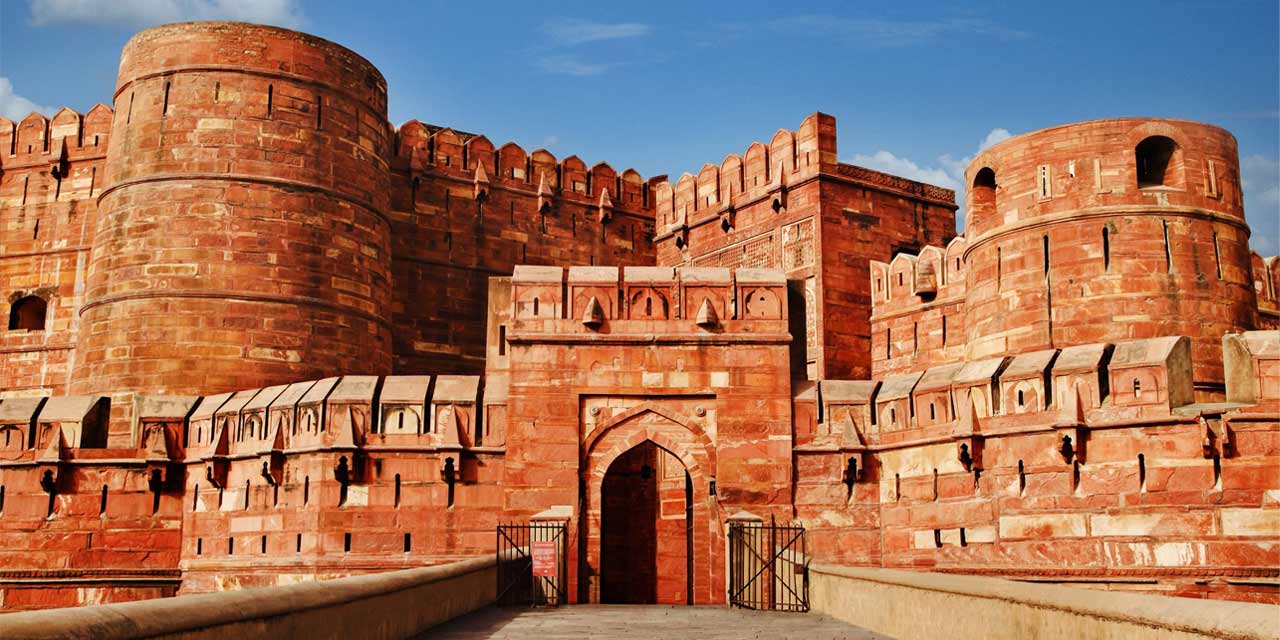Agra Fort Entry Fee
- 50 per person for Indians
- 650 per person for Foreign tourists
- 40 per person for Indians on Fridays
- 600 per person for Foreign tourists on Fridays
Agra Fort Phone
N/A
Rating:  | 4/5 stars
| 4/5 stars
Based on total 33 reviews
Agra Fort Address: Agra Fort, Rakabganj, Agra, Uttar Pradesh, 282003, India
Agra Fort Entry Tickets Prices
| Tourist Type | Amount (Rs.) |
|---|---|
| Domestic/Indian | 50/- |
| Foreign tourist | 650/- |
| Entry Below (Children Below Age 15) | Free |
Agra Fort Timings for Light and Sound Show
| Show | Timings |
|---|---|
| Hindi Show | 30 minutes after Sunset |
| English Show | Immediate after Hindi Show |
Agra Fort Entry Tickets Prices for Light and Sound Show
| Tourist Type | Amount (Rs.) |
|---|---|
| Indian | 70 |
| Student | 40/- |
| Foreign tourist | 200/- |
| Entry Below (Children Below Age 15) | Free |
Located close to River Yamuna is the magnificent Agra Fort. It offers a captivating glimpse into the royal lifestyle and architectural brilliance of the Mughal Empire. It’s one of the most popular historical tourist places of Agra. Here, you’ll find yourself immersed in the grandeur of Mughal architecture.
Explore the various halls like Diwan-e-Aam and Diwan-e-Khaas, and the palaces like Jahangir Palace and Khaas Mahal. Savour the moment of tranquillity and respite they offer. The high, red sandstone walls surround you completely. You’ll forget you’re in 21st-century Agra.
This enchanting UNESCO World Heritage site takes you on a journey through the opulent era of the Mughal Empire. History comes alive in this vast Red Fort of Agra.
No tour to Agra is ever complete without visiting the Agra Fort.
Back in the day, it served as the residence of the Mughal emperors until the capital was shifted to Delhi. You’ll feel the royal aura as soon as you step in. You can even get a view of the Taj Mahal, the world-famous architectural marvel, from the fort.
Where is Agra Fort situated?
Agra Fort is a vast structure on the banks of River Yamuna. It’s like a walled city in the centre of Agra, about 2.5 km from the Taj Mahal. Hire a guide and hear the stories of a bygone era as you walk through the sprawling corridors. Prepare to be captivated by its elegance.
History of Agra Fort
Agra Fort’s history dates back several centuries. It was originally owned by Rajput rulers. After the First Battle of Panipat (in 1526), Ibrahim Lodhi moved to this fort. Later, Babur, the first Mughal ruler, captured the fort.
When the fort came under the control of Akbar, it was almost in ruins and disintegrating. So, its construction began in 1565 and continued until 1573.
After its completion, Agra Fort served as the primary residence of Akbar. It also went through several modifications during the reign of subsequent emperors, Jahangir and Shahjahan. The fort was in its prime until 1638 when the capital shifted to Delhi. In 1658, it came under the control of Aurangzeb, the son of Shahjahan. He locked his father here until his death.
Agra Fort witnessed several battles throughout its history. And it witnessed the rise and fall of several Mughal rulers.
Numerous rulers seized control of the fort after the Mughals. In 1803, the British took over the Agra Fort. And after India’s Independence, it handed its authority to the Government of India.
Later, in 1983, Agra Fort was listed as a Heritage Site by UNESCO.
Image Gallery of Agra Fort
Architecture of Agra Fort
Agra Fort is a sprawling complex with massive walls stretching in a semi-circular shape for about 2.5 kilometres. It encompasses various structures, palaces and gardens. And they’re all an echo of the artistic taste of the Mughal rulers.
The fort is primarily constructed with red sandstone. It’s a blend of architecture influenced by Islamic, Persian and Hindu elements. You can witness its craftsmanship from the mammoth entry gates itself.
Among the most captivating places to see during your Agra Fort visit are Diwan-e-Aam, Diwan-e-Khas, Musamman Burj and several majestic palaces. All the structures are as magnificent as the others. The fort also has places of worship and a private market.
It has two gates – Delhi Gate and Lahore Gate (also known as Amar Singh Gate). For tourists, only Lahore Gate is open for Agra Fort entry.
Places to visit in Agra Fort
1. Diwan-e-Aam – Agra Fort Diwan-e-Aam was the hall where the emperors addressed the general public and listened to their concerns. Shahjahan initially had it built of red sandstone. Later, it was plastered to give a white marble look. The famous Peacock Throne was kept here back in the day.
2. Diwan-e-Khaas – Diwan-e-Khaas hall of Agra Fort was built by Shahjahan to hold private meetings and entertain important guests. The entire hall is intricately decorated with marble pillars studded with semi-precious stones. Another reason Diwan-e-Khaas is known for is its Pachisi courtyard. It’s a marble platform for the emperor and his courtiers to play the chess-like Pachisi board game.
3. Khaas Mahal – Khaas Mahal is another structure built by Shahjahan in the fort. It’s a private palace for the emperor, overlooking Angoori Bagh. It has some classical Persian and Islamic influences and exhibits delicate marble inlay work and elegant arches. The windows designed with decorative latticework are also worth admiring.
4. Sheesh Mahal – Sheesh Mahal (or Mirror Palace) was the private dressing room of the queens. And it’s one of the most exquisite constructions in the fort. Agra Fort’s Sheesh Mahal is known for its mirror work that reflects light in a mesmerizing way. It’s beautifully decorated with a mosaic of myriad tiny mirrors on its walls and ceiling.
5. Bengali Mahal – Bengali Mahal of Agra Fort is an ornate palace having a unique fusion of Bengali style of architecture with Mughal elements. It was built by Akbar and renovated by Shahjahan later. The palace is said to have underground apartments beneath its structure.
6. Shahjahani Mahal – Shahjahani Mahal (or Shahjahan’s Palace) is located near Diwan-e-Khaas. It’s said to be one of the first attempts of Shahjahan to turn a red sandstone palace into a white marble structure. And it’s a beautiful palace with intricate carvings and floral designs. He got the skeletal construction of brick and red stone redone with thick white plaster.
7. Akbari Mahal – Akbari Mahal (or Akbar’s Palace) was once a huge complex that served residential purposes for the royal women. It’s a red sandstone palace built by Akbar. Much of the palace is in ruins today, but it still offers a glimpse into the lifestyle of the Mughal women. Emperor Akbar is said to have taken his last breath here.
8. Jahangiri Mahal – Jahangiri Mahal (or Jahangir’s Palace) was the principal living complex for the wives of Akbar. It’s one of the first architectures that you'll encounter upon entering Agra Fort through the Amar Singh Gate. Its grand halls are covered with intricate stone carvings, decorative arches and heavily-fashioned brackets.
9. Hauz-e-Jahangiri – Located near Jahangiri Mahal, Hauz-e-Jahangiri (or Jahangir’s Hauz) is a monolithic water tank built by emperor Jahangir. It’s a part of Akbar’s Bengali Mahal. This tank was used for bathing during those days.
10. Muthamman Burj – Muthamman Burj is an octagonal tower in Agra Fort that served as Shahjahan’s personal retreat. It’s directly connected to Diwan-e-Khaas, Sheesh Mahal, Khaas Mahal and other palaces. Muthamman Burj was originally built of red stone. Shahjahan rebuilt it with white marble, and it’s one of his most ornamented buildings. The tower offers a majestic view of the Taj Mahal and Shahjahan spent his final years in captivity (of Aurangzeb) here.
11. Moti Masjid – Located close to the Diwan-e-Aam hall is the majestic Moti Masjid (or Pearl Mosque). And it’s known for its sheer grandeur and serene environment. It’s a pristine white marble mosque featuring three domes and a spacious courtyard.
12. Mina Masjid – Mina Masjid was the private shrine of Shahjahan. It’s a small mosque with a simple design devoid of any ornamentation. It’s located near Moti Masjid, and it’s enclosed on all sides by high walls.
13. Nagina Masjid – Nagina Masjid was another mosque built by Shahjahan near Moti Masjid. It’s a small but elegant structure made of white marble that served as a private mosque for the ladies of the royal family. It bears a very simple architecture with minimal decoration.
14. Meena Bazaar – Meena Bazaar used to be a lavish market held on the road near Nagina Masjid. The women of the family of Mughal courtiers and other officers used to set it up. And the members of the royal family used to shop in the market. While the market doesn’t exist anymore, you can still visit the place. A major part of the Meena Bazaar complex, though, is under the army’s control, and it’s restricted for tourists.
Other Things to do at Agra Fort
1. Capturing memorable photos – Agra Fort provides countless photo opportunities within its premises. You can capture intricate details and textures of the grand structures, of course. Apart from the grandeur of the palaces and their elaborate interiors, you can click views of the gardens and surroundings. From certain vantage points, such as Muthamman Burj, you can also capture breathtaking views of the Taj Mahal.
2. Taking in the serenity – Walking through the fort’s gardens, you’ll find moments of serenity within the walls. You can take a leisurely stroll through these idyllic gardens, relax amidst the greenery, and enjoy the peaceful ambiance. They’re perfect spots to admire the fort’s beauty while listening to its rich history.
3. Shopping for souvenirs – Streets around Agra Fort offer plenty of shopping experiences. The bustling shops have a wide range of items like embroidered fabrics, accessories, jewellery and other handicrafts. Leather goods, marble artifacts and other home decor items are also available in various shops around the town.
Agra Fort Timings and Entry Fees
You can visit Agra Fort throughout the year, on all days of the week. The opening hours of Agra Fort are from sunrise to sunset.
The entry fee for Agra Fort is ₹50 per person for Indian citizens and ₹650 for foreign visitors. On Fridays, its ticket prices are ₹40 and ₹600, respectively. For children below 15 years, entry is free.
Best time to visit Agra Fort
It’s best to visit Agra Fort during winter (from November to February). The weather is the most comfortable on those days to have fun exploring the place. For the best experience, visit it during the morning or late afternoon hours.
Time to explore Agra Fort
If you want to explore Agra Fort properly, you should have at least 2-3 hours. The complex is spread across a large area. It has several halls, palaces and other places to visit.
Things to keep in mind when visiting Agra Fort
- Carry your identity card.
- Wear comfortable footwear.
- Keep a hat and sunglasses.
- Carry a bottle of water.
- Apply sunscreen creams.
- Luggage should be stored in the cloakroom.
- Smoking and drinking are strictly prohibited.
- Eating and littering are also restricted.
- Mobile phones must be kept silent, switched off, or in flight mode.
- Take a guided tour for the best experience.
How to reach Agra Fort?
Agra Fort is built on the banks of River Yamuna, almost at the centre of Agra. The distance from the Taj Mahal to Agra Fort is about 2.5 km. Agra Fort distance from Idgah bus stand is 4 km and from Agra Cantt railway station is 5 km. Agra Fort railway station is the nearest railway station, only a few hundred metres away. From Agra airport, the fort is 7 km away. The nearest international airport is in Delhi (about 230 km away).
And here are the different ways to reach Agra Fort world heritage site –
By bus – Buses are available from many parts of Agra. Bijli Ghar is the nearest bus stand to Agra Fort, only a few hundred metres away. From the bus stand, you can walk the distance or take an auto-rickshaw or e-rickshaw to the fort.
By auto/e-rickshaw – Auto rickshaws, cycle rickshaws and e-rickshaws are easily available in all parts of Agra. They’re a convenient means of transport to explore different tourist places, including Agra Fort.
By cab/taxi – Hiring a cab or taxi is the best way to visit the Agra Fort complex. You can get cabs from many places or book one from the top car rental companies in Agra easily. They’re the most comfortable way to explore the fort and nearby places.
FAQs about Agra Fort
Explore the famous city of Agra by booking a Agra tour package with us. At Agra Tourism, a division of Holidays DNA, we offer personalized tours to suit your budget and other interests. To know more about our offerings, please fill the Contact Us form.






